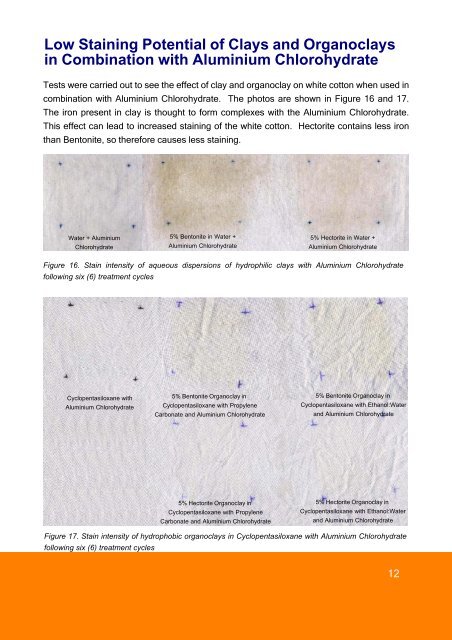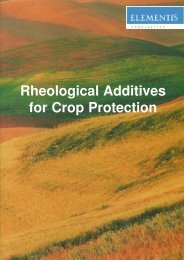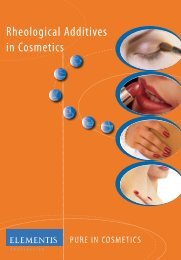Comparison of Smectite Clays in Underarm Products - Elementis ...
Comparison of Smectite Clays in Underarm Products - Elementis ...
Comparison of Smectite Clays in Underarm Products - Elementis ...
You also want an ePaper? Increase the reach of your titles
YUMPU automatically turns print PDFs into web optimized ePapers that Google loves.
Low Sta<strong>in</strong><strong>in</strong>g Potential <strong>of</strong> <strong>Clays</strong> and Organoclays<br />
<strong>in</strong> Comb<strong>in</strong>ation with Alum<strong>in</strong>ium Chlorohydrate<br />
Tests were carried out to see the effect <strong>of</strong> clay and organoclay on white cotton when used <strong>in</strong><br />
comb<strong>in</strong>ation with Alum<strong>in</strong>ium Chlorohydrate. The photos are shown <strong>in</strong> Figure 16 and 17.<br />
The iron present <strong>in</strong> clay is thought to form complexes with the Alum<strong>in</strong>ium Chlorohydrate.<br />
This effect can lead to <strong>in</strong>creased sta<strong>in</strong><strong>in</strong>g <strong>of</strong> the white cotton. Hectorite conta<strong>in</strong>s less iron<br />
than Bentonite, so therefore causes less sta<strong>in</strong><strong>in</strong>g.<br />
Water + Alum<strong>in</strong>ium<br />
Chlorohydrate<br />
5% Bentonite <strong>in</strong> Water +<br />
Alum<strong>in</strong>ium Chlorohydrate<br />
5% Hectorite <strong>in</strong> Water +<br />
Alum<strong>in</strong>ium Chlorohydrate<br />
Figure 16. Sta<strong>in</strong> <strong>in</strong>tensity <strong>of</strong> aqueous dispersions <strong>of</strong> hydrophilic clays with Alum<strong>in</strong>ium Chlorohydrate<br />
follow<strong>in</strong>g six (6) treatment cycles<br />
Cyclopentasiloxane with<br />
Alum<strong>in</strong>ium Chlorohydrate<br />
5% Bentonite Organoclay <strong>in</strong><br />
Cyclopentasiloxane with Propylene<br />
Carbonate and Alum<strong>in</strong>ium Chlorohydrate<br />
5% Hectorite Organoclay <strong>in</strong><br />
Cyclopentasiloxane with Propylene<br />
Carbonate and Alum<strong>in</strong>ium Chlorohydrate<br />
5% Bentonite Organoclay <strong>in</strong><br />
Cyclopentasiloxane with Ethanol:Water<br />
and Alum<strong>in</strong>ium Chlorohydrate<br />
5% Hectorite Organoclay <strong>in</strong><br />
Cyclopentasiloxane with Ethanol:Water<br />
and Alum<strong>in</strong>ium Chlorohydrate<br />
Figure 17. Sta<strong>in</strong> <strong>in</strong>tensity <strong>of</strong> hydrophobic organoclays <strong>in</strong> Cyclopentasiloxane with Alum<strong>in</strong>ium Chlorohydrate<br />
follow<strong>in</strong>g six (6) treatment cycles<br />
12







